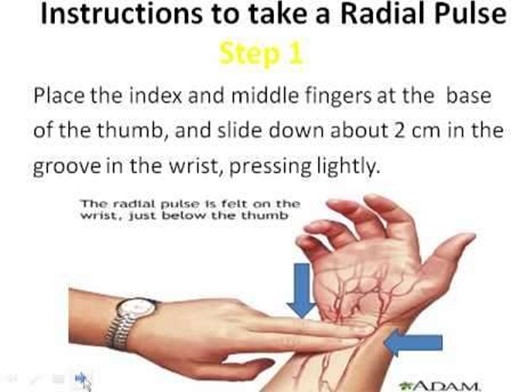Which of the following would be appropriate to evaluate learning in the psychomotor domain? The participant will:
Demonstrate how to palpate (feel) their pulse and correctly count their pulse.
Describe how to check their blood pressure.
Differentiate between two different types of vitamins.
Verbally state the reasons for checking their heart rate before taking their medication.
The Correct Answer is A
The psychomotor domain involves physical movement and coordination.

Evaluating learning in the psychomotor domain would involve observing the participant’s ability to perform a physical task, such as palpating their pulse and correctly counting it.
Choice B is not the correct answer because describing how to check blood pressure involves cognitive knowledge rather than physical movement or coordination.
Choice C is not the correct answer because differentiating between two different types of vitamins involves cognitive knowledge rather than physical movement or coordination.
Choice D is not the correct answer because verbally stating the reasons for checking heart rate before taking medication involves cognitive knowledge rather than physical movement or coordination.
Nursing Test Bank
Naxlex Comprehensive Predictor Exams
Related Questions
Correct Answer is C
Explanation
Health education involves different modes of communication like lectures, group or panel discussions, symposia, poster or exhibit presentation etc.
Computer games, songs and brochures can all be used as methods to present health education.
Choice A is not the answer because computer games are just one of the many methods that can be used to present health education.
Choice B is not the answer because songs are just one of the many methods that can be used to present health education.
Choice D is not the answer because brochures are just one of the many methods that can be used to present health education.
Correct Answer is D
Explanation
The World Health Organization (WHO) is a specialized agency of the United Nations responsible for international public health.
It would be the most reliable source for data on the health of the Iraqi people.
Choice A is incorrect because the Kaiser Foundation is a non-profit organization focused on national health issues and the U.S. role in global health policy.
Choice B is incorrect because the Centers for Disease Control and Prevention (CDC) is a national public health institute in the United States.
Choice C is incorrect because the Department of Health and Human Services is a department of the U.S. federal government responsible for protecting the health of all Americans.
Whether you are a student looking to ace your exams or a practicing nurse seeking to enhance your expertise , our nursing education contents will empower you with the confidence and competence to make a difference in the lives of patients and become a respected leader in the healthcare field.
Visit Naxlex, invest in your future and unlock endless possibilities with our unparalleled nursing education contents today
Report Wrong Answer on the Current Question
Do you disagree with the answer? If yes, what is your expected answer? Explain.
Kindly be descriptive with the issue you are facing.
